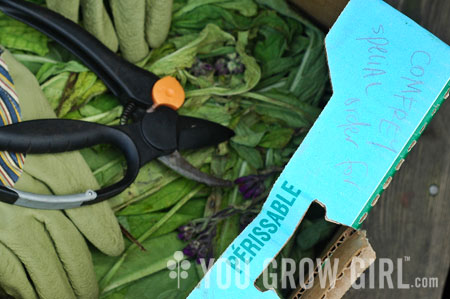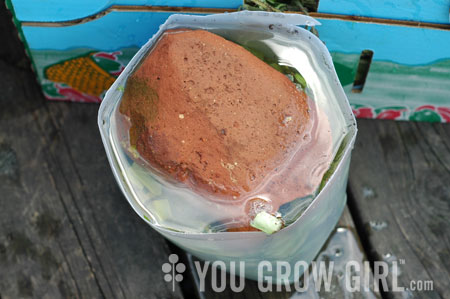
I recently wrote about the nutritional benefits of mulching and fertilizing with sea kelp. A commenter mentioned using comfrey, to which I replied that I am a big fan of comfrey as a fertilizer and would recommend it as a mulch, although I would suggest chopping it up or drying first since the leaves are very large and would form a dense mat when wet.
Comfrey is definitely worth growing as a ready made source of potassium, magnesium, and phosphorous if you’ve got the space. The trouble is it is awfully aggressive and will take over where ever you plant it, and then some. This is why I don’t grow it. I do however, have a secret location where I go every year to harvest a bit to make into liquid feed. That was until this year when I went to harvest from my secret stash and discovered it was no longer accessible. Noooooooo……
The tally so far: Summer is too wet and too cold, the tomato harvest is mostly crappy, and I can’t get any comfrey. The horrors.
But then, a happy turnaround. The other day I ran into a fellow forager/gardener. The subject of nettles came up which lead to comfrey and my recent loss. She mentioned that the farm she works for has a huge patch of comfrey that they use for making their own fertilizer. All I had to do was pay for the time it takes her to pick the leaves. Two days later I rode over to a local market and picked up a big box of comfrey. And while it did rain briefly, Monday was oppressively hot and humid so I stopped at the hardware store on the way home and bought a fan for my office window. Then I balanced a box of comfrey and a fan on top of my bike basket and walked it home because I am not adept enough to ride while balancing both, unlike those dudes you see balancing a twenty-four case of beer (we call it a two-four around these parts) on top of the turned around handlebars of their 10-speed with one hand and a six pack dangling from the other. While I’m on the subject of death-defying balancing feats on a bicycle, I once saw a guy balancing a massive rug on the handlebars while riding. On another occasion, I witnessed a guy with a TV, although that didn’t work out and the TV smashed onto the road.
And that, friends, is the story of the week summer finally arrived (we’ve had sun AND heat for days!), hope returned for our tomatoes, and I got my comfrey. Things are looking up.

1. Chop up the comfrey with a pair of sheers or scissors and soak in a tub of water. I put a brick on top to hold it all underneath the liquid. 2. Let it sit for a day or two until it gets stinky and the leaves are broken down. 3. Strain off the leaves and put them in the compost bin or bury them in the garden. 4. Use the remaining liquid as a fertilizer by spraying on the leaves of your plants or pouring into the soil around the roots.
Glad it worked out for you!
I’m sure the feed will be great. If you have this disaster again you could try borage. It grows like billy-o and the flowers are useful for their own reasons, as I’m sure you know, but the leaves make a really good feed and is slightly less stinky in the prep in my experience.
Bet your plants are going to love you for your perseverence though!
Hmmm, I have a comfrey patch but have never made fertilizer out of it. I think I might have to try this.
I have comfrey on various parts of my property – the result of pulling it out of the two garden beds where it comes up and then tossing it into our woods, where it’s totally out of control. This is definitely a must-try! Gayla, if you were here, I would totally share!
Gayla, do you think comfrey would work in a container? I am thinking if it did, you’d have grown it in one already… if not, I might try finding seed or a few plants somewhere to start with and just sticking it in a pot where it can’t take over our small urban yard!
I let my comfrey leaves sit for a lot longer in the bucket of water (like two months). It does smell really disgusting but it gets very potent and black and lasts longer and goes much further. You have to dilute it in a bucket of water -about one cup to a bucket-but that makes well over ten buckets of comfrey ‘tea’ out of one bucket of comfrey leaves- useful for those without a regular access to comfrey plants. I’ve contained my comfrey in a brick edged bed- about three feet square and it’s been prolific and non-spreading for 22 years.
Jennifer: I’ve never tried it, but that doesn’t mean it won’t work. It’s a big plant though so I’d try a big pot!
Best to grow in the ground as the roots go way down deep into the ground bringing up the nutrients that make comfrey so useful, as a liquid feed and indeed for medicinal and nutritional purposes. for example very rich in iron. anyone with an iron deficiency, cook like spinage, a portion a day will resolve. excellent for broken bones – one of it’s names is boneknit, or knitbone.
Growing in pots would not be a good idea, given the above.
I found your site, whilst looking for where comfrey will grow, having just learnt there is a serious iron deficiency amongst children in Cuba.
I see this is a ‘Girl’ site, so hope me being a bloke, it is ok for me to write! Being a spiritual healer i work mainly with women anyway, thank goodness!
Hope this helps. Melvyn
Melvyn: You’ve made a very good point. You can grow it in a container… in that it will live… but might not bear the nutritional content.
I am trying out a variegated Russian comfrey which is apparently smaller, less ferocious and the seeds less fertile. It is a gorgeous plant – wish I could post a picture – and it is certainly a vigorous grower in its first season, but I’m not worried, yet.
What I am doing is harvesting the large leaves periodically and using them as mulch (might try a tea myself).
Comfrey is the queen of my garden. I started out with one plant and now have about seven or eight! I have successfully grown comfrey in black plastic pots for years. The holes are big enough for the root to leave the pot and go into the earth in search of nutrients. The pots help to control its spread and allow me to move them around the garden. You can also cut the leaves of the comfrey and lay them on the soil as mulch for other growing plants–great weed control!